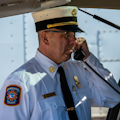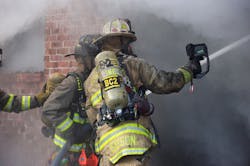Command & Control Success: Fireground Commander: Understanding the Impact
Fireground commanders (FGCs) must understand the importance of sizing up their contribution percentage to mitigating operational needs and that actions on the fireground are dependent on their order of arrival to the scene.
FGCs also should arrive in a properly equipped vehicle that’s based on their fire department response model and organizational structure—for example, a chief who never is the first to arrive or who never must operate alone, or a chief of a county-type fire department who might be the first to arrive and must wait for the first-arriving company.
Only yourself to ‘command’
Chiefs or FGCs who arrive first are 100 percent of the staffing on scene until additional firefighters arrive. Working in a large county fire department creates a high possibility of arriving first and operating alone for a while—in other words, the only firefighter who is on scene who can do something. There’s no one to command—other than himself or herself to act and size up what one person can do to start to save lives and to reduce property loss immediately.
Taking action is even more critical in bread-and-butter operations, such as a single-family dwelling fire and an outside fire that’s extending to a building.
Although national standards for equipment that’s carried on fire apparatus exist, there aren’t any for what fire command vehicles should carry—I mean more than markers and a fancy command board that has different color magnets. All command vehicles should have operational fireground equipment, including complete bunker gear, an air pack, a thermal imaging camera (TIC), a large hand light, a set of irons, a water can and extinguishers, including a CO2 extinguisher and a dry chemical extinguisher. I carry these tools and more in my battalion chief vehicle, and I have multiple fireground experiences to show why you should have them.When you’re the 100 percent
When an FGC/chief is 100 percent of the solution until additional firefighters arrive, the FGC/chief must evaluate getting out of the buggy and possibly getting a closer look to see whether he or she can have an immediate effect. Simply going to the front door of a private dwelling with a TIC and a set of irons can reveal critical factors to assist with the size-up and necessary resources. It’s possible that the fire is within the capabilities of a water can, a garden hose or a fire extinguisher or even just shutting a door to confine the fire.
Even if no one is trapped and all reports that everyone got out seem solid, a first-due 360 is key to initial company and command success. This 360 of the building might identify the possible different options for entry and exit. In this way, the FGC can prompt the first-arriving engine on size, length, location and proper staffing that’s needed to be successful with the first attack line. Getting out and getting a closer look also could indicate: where to place a second line, if needed; where to start the search; a targeted search, such as VES; and whether to use an entry point other than the front door.
It also can reveal an immediate rescue just inside of the front door. In my column in this space in the November 2021 issue, “Command Post Location,” I wrote about Fire Chief Adam Magers arriving first at a working fire in a two-story private dwelling, where he got out of his buggy to get a better size-up and made an immediate rescue of a trapped occupant. This is an example of going beyond the command post location and understanding tactical command. There’s a good chance that the occupant would have succumbed if Magers didn’t get out of his command buggy.
TIC and hand light
A TIC and a hand light are more than just search tools. FGCs should have the TIC every time that they get out of the buggy, to start sizing up the building. The hand light is equally essential, to increase visual abilities at night and in smoky environments. These tools can provide command success by enhancing images that the human eye can’t see within a building or in low-light conditions and are essential for acquiring intelligence that will aid significantly in commanding the incident.
A TIC is as much an outside tool as it is an inside search tool. You must use it to its full capabilities to provide a better fire attack.
Second to using a TIC for search is using it for size-up, so you get the most realistic image of what’s within and behind the smoke. It gives the FGC the advantage of reading the smoke and what it’s camouflaging. A TIC is a set of binoculars and a magnifying glass combined times 10. It allows you to see through today’s combustion products to visualize heat buildup and fires within lightweight-constructed floors and within roof assemblies that contain massive amounts of void spaces that are subject to early collapse. With early recognition, an FGC immediately can order the ceiling or void space to be opened to cool, suppress and extinguish the fire.
A TIC can allow an FGC or other command staff to see whether water actually is going where it needs to go and whether it’s cooling these areas effectively. (In our modern fires, it’s possible for the BTUs to be beyond the gpms and for water application to be ineffective.) A TIC also can show fire extension to other areas, which can give an FGC good intelligence to order additional attack lines and open up these areas.
Extinguishers & ‘the green line’
Knowing that I have the opportunity to arrive ahead of other responding fire companies, I carry a full complement of extinguishers, including two water cans, a large dry chemical extinguisher and a smaller CO2 extinguisher. This gives me multiple weapons to choose, each of which complements the other in its deployment, depending on what’s burning if I arrive first.
On the numerous fires where I arrived first due in my chief buggy, I used one or two water cans to keep a fire from extending or to strictly hold the fire for a minute or two until a fire company arrived.
Most of us went to a fire where the police or a neighbor suppressed the fire using a garden hose before our arrival. I, too, used the typical residential garden hose to control a fire by either taking it inside or applying the stream through a window. Although utilizing “the green line” is unconventional to some, you should use common sense and act as though it’s your neighbor’s house that’s on fire. Even a properly applied garden hose that’s used from outside of the immediately dangerous to life and health (IDLH) environment can minimize property loss significantly.
In September 2004, as a newly promoted chief, I pulled up on a burning pile of Hurricane Ivan debris that was located directly next to a large restaurant on Pensacola Beach. The burning pile already had extended to the restaurant’s highly combustible wood siding, which had been preheated directly from summer sunlight. Had it not been for the numerous water cans and dry chemical extinguishers that I carried—it was a few minutes before the first fire company arrived—the restaurant would have been a multiple-alarm fire, most likely destroyed. That would have had a devastating effect on the community, because, at the time, it was the only restaurant that was providing food on the island.
The irons
The irons allow you to force entry or take a window for an immediate rescue. I arrived first many times to an occupied house fire that required me to force entry and to get a better size-up of the interior for life safety.
On one occasion, I used the set of irons from my buggy to force the front door of a private dwelling, with an unconscious civilian trapped behind the front door because of a double-sided deadbolt that kept the occupant from rapidly unlocking from the interior.
On many other occasions, I forced the front door or side door, so that step was completed before the arrival of an engine company, thereby reducing the reflex time for the engine company to get a line inside.
When you aren’t the 100 percent
Across the country, we all responded to reports of fires where someone stated that everybody was out of the fire building or that the fire building was a vacant home, only to, in fact, learn that there were trapped occupants.
In January 2021, a single 9-1-1 call reported a working fire in a single-family dwelling. All the neighbors said everyone was out. Upon my arrival, the first engine stretched and operated directly on the main body of fire. Yes!
I established command at the rear of my vehicle based on arriving after a fire company. A ladder company arrived shortly after I arrived. Several other fire companies arrived within the next couple of minutes.
I assigned the ladder company to make entry opposite of the fire attack, so they wouldn’t be delayed getting to the unburned side and bedroom section of the house that had survivable space. Within a minute of entry via a rear bedroom window, the ladder company radioed that an unconscious victim was located just beyond the bedroom door. This incident is an excellent example of understanding the concept of VES and when to go beyond the bedroom door.
So, when an FGC/chief arrives behind a fire company, it drastically changes the actions that are taken by the FGC/chief. Consider it this way: The FGC arrives after nine firefighters on three different fire companies arrived. The FGC/chief is 10 percent of the staffing and now must focus more on command and control, because more firefighters should arrive shortly.
Fireground command flexibility
Regardless of the location of command on the fireground, it must be understood that size-up and flexibility is critical to have command success on the fireground. No one fireground command style works perfectly for all incidents. A good size-up and understanding of the arrival sequence of additional firefighters and how that sequence plays into who will do the tactics to mitigate the incident in the shortest amount of time are vital.
FGCs shouldn’t get locked into one mode of thinking and how they operate. Always size-up your percentage of effect before, during and after each incident, so you can continue to increase your effect on the next fire. Be the FGC who brings more than just a voice on the radio. Truly provide some command presence.
About the Author

Curt Isakson
Curt “Ike” Isakson is a 30-plus-year veteran of the fire service. He worked for Escambia County, FL, Fire Rescue for 25 years. Isakson previously worked nine years for the Pensacola, FL, Fire Department, where he was assigned as a company officer on Heavy Rescue 31. His fire service experience started at a young age as a junior firefighter with the Midway, FL, Fire District; he rose through the ranks to captain. Isakson's identification of the need for a series of special-interest fire conferences spawned the development of County Fire Tactics, which covers officer development, command officers, water on fire, high-rise operations, and leadership and tactics.

